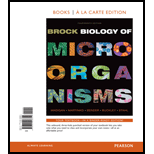
To explain:
The aerobic chemolithotrophs and chemoorganotrophs are physiologically different and share a number of features with respect to the production of ATP. Discuss these common features with the reasons why the growth yield grams of cells per mole of substrate consumed of a chemoorganotrophs respiring glucose are so much greater than for a chemolithotroph respiring sulfur.
Concept introduction:
A bacteria that have the capacity to obtain its energy by the oxidation of reduced inorganic compounds such as hydrogen, ammonia, and sulfide are called as the chemolithotrophs. An organism that obtains energy from the oxidation of reduced organic compounds are termed as the chemoorganotrophs.
Want to see the full answer?
Check out a sample textbook solution
Chapter 13 Solutions
Brock Biology of Microorganisms, Books a la Carte Edition (14th Edition)
- The standard reduction potential for ubiquione (A or coenzyme Q) is .045 V, and the standard reduciton potential (E) for FAD is -0.219 V. Using these values, show that the oxidation for FADH2 by ubiquinone theoretically liberates enough energy to drive the synthesis of ATP. Faraday constant =96.48KJ/Vol delta G' standard for ATP Synthesis is +30.5 KJ/mol R=8.314 J/mol K=1.987 cal/mol Karrow_forwardAnaerobic production of ethanol by Saccharomyces cerevisiae is associated with yeast growth. The steady-state growth kinetics of yeast follows Monod. It is intended to produce 10 kg/h of ethanol in an ideal CSRT-type fermenter, fed by a solution of 50 g/L of glucose. Size the fermenter for this purpose (calculate its working volume), setting the biomass concentration at the exit of the fermenter at 6.9 g/L.arrow_forwardWhat is the net yield of ATP during homolactic, acetate, and butyrate fermentations? How do these yields compare to aerobic respiration in terms of both quantity and mechanism of phosphorylation?arrow_forward
- Under standard conditions, is the oxidation of ubiquinol (Coenzyme Q) by O2 sufficiently exergonic to drive the synthesis of ATP? If yes, how many ATP can be synthesized assuming 100% efficiency?arrow_forwardOrganisms growing anaerobically cannot perform glycolysis for long without reducing the pyruvate from glycolysis into another compound, most commonly to lactate or to ethanol plus CO2. Both of these reactions are given below in their unbalanced forms. Explain in one sentence why one of these reducing steps is needed to sustain anaerobic glycolysis.arrow_forwardIn the microbial community of the bovine rumen, the actual AG value has been calculated for glucose fermentation to acetate: CaH12O6 + 2H20 → 2CH:03 + 2H+ + 4H2 + 2CO; AG =-318 kJ/mol If the actual AG for ATP formation is 44 kJ/mol and each glucose fermentation yields four molecules of ATP, what is the thermodynamic efficiency of energy gain? Where does the lost energy go? Why is the AG not 31 kJ/mol?arrow_forward
- Under standard conditions, NADH reoxidation by the electron-transport chain has a free-energy change equal to –220 kJ/mol. With 100% efficiency, how many ATP could be synthesized under standard conditions? What is the "actual" efficiency given these numbers?arrow_forwardDefine an oxidation/reduction (redox) reaction. Why are redox reactions important in cellular respiration?arrow_forwardBased on its structure, describe how you would expect the presence of increasing concentrations of Vitamin D3 to affect the thermotropic phase transitions, and hence the DSC thermogram, of DPPC bilayers (vesicles).arrow_forward
- Anaerobic production of ethanol by Saccharomyces cerevisiae is associated with yeast growth. The steady-state growth kinetics of yeast follows Monod. It is intended to produce 10 kg/h of ethanol in an ideal CSRT-type fermenter, fed by a solution of 50 g/L of glucose. Size the fermenter for this purpose (calculate its working volume), setting the biomass concentration at the exit of the fermenter at 6.9 g/L.Note: CSTR = Continuous Stirred Tank ReactorData: μmax = 0.1 h-1; Ks = 0.5 g/L; YX/S = 0.15; YP/S = 0.45.(answer: V = 5435 L)arrow_forwardBoth the yeast Saccharomyces cerevisiae and the bacterium Zymomonas mobilis produce ethanol from glucose under anaerobic conditions without external electron acceptors. The yield of cell biomass from glucose is 150 mg/g for yeast and 75 mg/g for Z. mobilis. In both cases, the nitrogen source is ammonia (NH3) and both cellular compositions are represented by the formula CH1,8O0,5N0,2. (a) What is the yield of ethanol from glucose in both cases? (b) Based on the results of part (a), which microorganism seems most efficient for the production of industrial ethanol?arrow_forwardConsider the following types of cell and their respective conditions: a cell with ATP synthase deficiency* a yeast cell undergoing fermentation but with defective alcohol dehydrogenase (hint: In yeast, alcohol dehydrogenase is responsible for shuttling reducing equivalents of cytosolic NADH to the mitochondria.)* a brain cell with non-functional Complex II of the electron transport chain* * Assume that the deficiency is isolated and will not influence the function of other respiration components In these cells/tissues, determine the following from the catabolism of the 2.5 moles of the disaccharide lactose (will be hydrolyzed first to yield glucose and galactose). a. Net ATP from glycolysis b. ATP from oxidative decarboxylation (if applicable) c. ATP formed from Krebs cycle (if applicable) d. Total net ATParrow_forward
 BiochemistryBiochemistryISBN:9781305577206Author:Reginald H. Garrett, Charles M. GrishamPublisher:Cengage Learning
BiochemistryBiochemistryISBN:9781305577206Author:Reginald H. Garrett, Charles M. GrishamPublisher:Cengage Learning
